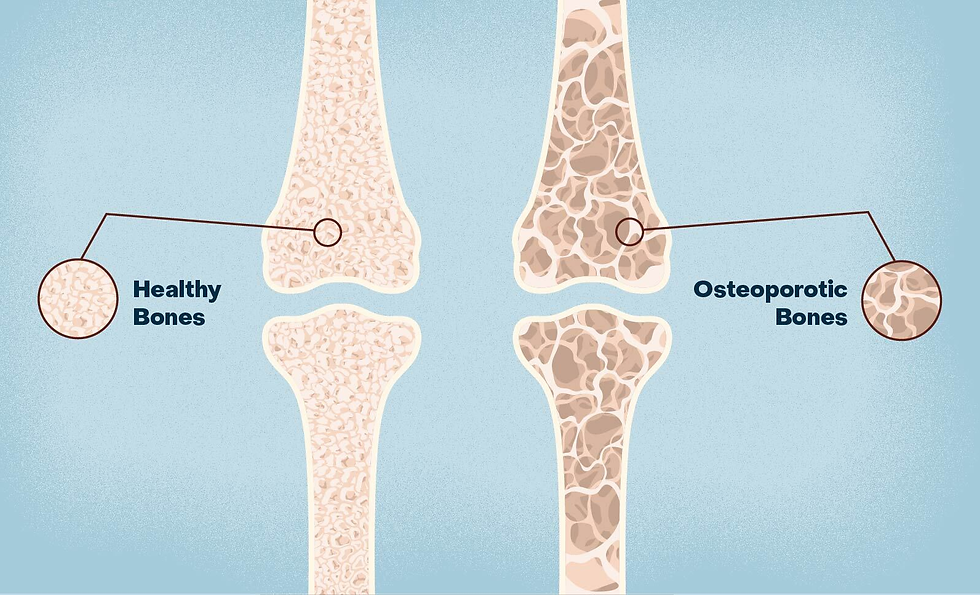
Understanding Osteoporosis: Protect Your Bones
- carolinecannon20080
- Feb 4
- 4 min read
Understanding Osteoporosis: Protect Your Bones
Osteoporosis is a bone disease that impacts millions of people worldwide. For many people, osteoporosis remains undiagnosed until it causes significant problems in the bone. There are many factors to osteoporosis ranging from genetics to diet. Taking care of your bones now can help ensure a stronger future, free from the limitations of fractures and mobility issues. Read the following blog to learn more about this bone disease that impacts many.
What is Osteoporosis?
Osteoporosis is a bone disease that develops when bone mineral density and bone mass decreases, or when the structure and strength of the bones change. The bone is a living tissue that is constantly being replaced by new tissue. With osteoporosis, the breaking down of old tissue occurs more rapidly than the production of new tissue. This can lead to a decrease in bone strength that can increase the risk of fractures. Osteoporoses is known as a silent disease because there are no extreme symptoms that let one know they may suffer from this. Many are unaware they have this disease until bones begin to break.

Causes and Risk Factors of Osteoporosis
There are many things that cause osteoporosis, ranging from things we cannot control to habits we can control. Some causes of osteoporosis consist of aging, hormonal changes, genetics, and lifestyle. The most common causes of osteoporosis include:
· Age- As people age, the bone mass decreases. This decline typically begins around the age of 30. At this point, the body starts to lose bone mass faster than it can replace it, which increases the risk of osteoporosis
· Gender- Women over the age of 50, post-menopausal, are at a higher risk of developing osteoporosis. Men with low levels of testosterone are also at a higher risk because testosterone helps keep bones strong.
· Genetics- A family history of osteoporosis increases the risk of developing the condition. Certain genetic factors can cause individuals to have lower bone density or to a higher rate of bone resorption.
· Poor Diet and Vitamin Deficiency- Eating bad foods or not eating enough can limit the amount of nutrients the body has. Calcium and Vitamin D have important minerals and nutrients that promote positive bone health.
· Lack of Physical Activity- Walking, running, and strength training stimulates bone growth and helps maintain bone density.
· Underlying Health Conditions- Some health condition such as endocrine/hormonal diseases, gastrointestinal diseases, rheumatoid arthritis, cancer, HIV/AIDS, and anorexia nervosa can cause osteoporosis because of inflammation in the body.
Symptoms of Osteoporosis
In the early stages of osteoporosis, there are very few signs that could tell someone they are suffering from osteoporosis. In the later stages of osteoporosis, there are symptoms that could correlate with suffering from osteoporosis.
· Loss of Height- A common symptom of osteoporosis is losing height due to compression fractures in the spine. Compression fractures can cause the vertebrae to collapse, making them shorter in height.
· Fracturing a Bone- If someone has a minor fall and fractures a bone, this shows the person may have weak bones and is a sign of osteoporosis.
· Back and Neck Pain- The same compression fractures that can cause loss of height also cause pain to the back and neck. The collapsed vertebrae may pinch the nerves that are around the spinal cord.
Living With Osteoporosis
Osteoporosis can significantly impact daily life by affecting mobility, independence, and overall well-being. Simple tasks like bending over to tie shoes or carrying groceries may become difficult or risky. People with osteoporosis have to modify their routines, such as avoiding certain exercises or activities that could lead to injury. Chronic pain from fractures or compression in the spine can also make it harder to sleep or engage in social activities. As bone density decreases, posture may change, leading to a hunched back or stooped appearance, which can also affect confidence and body image. The cost of treatments, medications, and mobility aids can be a financial burden. In some cases, individuals may need to modify their homes with grab bars, ramps, or other safety measures to prevent falls. Osteoporosis can alter the course of daily living, requiring adjustments in lifestyle and the support of loved ones to maintain a good quality of life.
Prevention and Treatment
There is no known cure for osteoporosis, but the symptoms of your disease can be managed with medicines and lifestyle changes. Many medications helpful are helpful with prevention of osteoporosis:
· Bisphosphonates- Medications containing bisphosphonates (Alendronate, Risedronate, Ibandronate, Zoledronic acid) help prevent bones from losing calcium and other minerals by slowing or stopping the natural processes that dissolve bone tissue.
· Teriparatide (Bonsity, Forteo)- A powerful drug that stimulates new bone growth
· Romosozumab (Evenity)- The newest bone-building medicine to treat osteoporosis
Citations:
Staff, Mayo Clinic. “Osteoporosis.” Mayo Clinic, Mayo Foundation for Medical Education and Research, 24 Feb. 2024, https://www.mayoclinic.org/diseases-conditions/osteoporosis/symptoms-causes/syc-20351968
Ucsdhealth. “Osteoporosis Risk Factors.” UC San Diego Health, 2024, https://health.ucsd.edu/care/endocrinology-diabetes/osteoporosis/risk-factors/#:~:text=While%20men%20and%20women%20of,Men%20with%20low%20testosterone%20levels.
Team, The Healthline Editorial. “Osteoporosis Symptoms.” Edited by Daniel Wiznia, Healthline, Healthline Media, 10 July 2024, https://www.healthline.com/health/osteoporosis-symptoms#risk-factors
Direct, Health. “Osteoporosis.” Healthdirect, 22 June 2023, https://www.healthdirect.gov.au/osteoporosis#symptoms




Comments